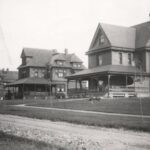The Bellefonte Academy was a popular private school that educated students from Centre County and across Pennsylvania for more than 125 years. The “School in the Mountains,” as it was known, operated from 1805-1934, except during the War of 1812 and Civil War.
The Bush House was a four-story hotel situated along Spring Creek in downtown Bellefonte built by Daniel G. Bush. Before it was destroyed by fire in 2006, it was a contributing property in the Bellefonte National Historic District.
Fred Lewis Pattee was an author, literary scholar, and English professor at Penn State. He wrote the alma mater and made numerous other contributions to the college. The Pattee Library is named for him.
Robert Cole was a self-trained architect who designed some of Bellefonte’s best-known buildings, as well as churches, homes and other structures in Centre County.
Julia Gregg Brill was the first female professor in Penn State’s English Department where she taught composition from 1924 to 1954. She was a tireless advocate for women and recognized by the university for her work.
At least twenty-eight Black men from Centre County served in the U.S. Colored Troops during the Civil War. Their experiences provide insight into the recruitment of the North’s Free Blacks into the army during the war.
Shortly before the dawn of the automobile age, two Centre County railroads established summer recreational parks that attracted thousands of visitors annually. Hecla Park and Hunters Park were built to create modest but dependable sources of income that helped railroads weather the ups and downs of the freight business.
In the late 19th and early 20th centuries, Penn State built on-campus cottages to house faculty members. In the years since, the cottages have served many purposes and three still fulfill important roles on the campus.
The Alpha Fire Company is the volunteer company that serves State College, Penn State, and the surrounding townships. The company was founded in 1899 as the Union Fire Company. A year later, the name was changed to Alpha Fire Company.
Peter Gray Meek was the controversial editor of the Democratic Watchman for more than fifty years. He was widely known for his editorials opposing the Civil War, which led to his arrest several times.




